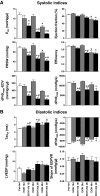Chronic plus binge ethanol feeding induces myocardial oxidative stress, mitochondrial and cardiovascular dysfunction, and steatosis
- PMID: 27106042
- PMCID: PMC4935511
- DOI: 10.1152/ajpheart.00214.2016
Chronic plus binge ethanol feeding induces myocardial oxidative stress, mitochondrial and cardiovascular dysfunction, and steatosis
Abstract
Alcoholic cardiomyopathy in humans develops in response to chronic excessive alcohol consumption; however, good models of alcohol-induced cardiomyopathy in mice are lacking. Herein we describe mouse models of alcoholic cardiomyopathies induced by chronic and binge ethanol (EtOH) feeding and characterize detailed hemodynamic alterations, mitochondrial function, and redox signaling in these models. Mice were fed a liquid diet containing 5% EtOH for 10, 20, and 40 days (d) combined with single or multiple EtOH binges (5 g/kg body wt). Isocalorically pair-fed mice served as controls. Left ventricular (LV) function and morphology were assessed by invasive pressure-volume conductance approach and by echocardiography. Mitochondrial complex (I, II, IV) activities, 3-nitrotyrosine (3-NT) levels, gene expression of markers of oxidative stress (gp91phox, p47phox), mitochondrial biogenesis (PGC1α, peroxisome proliferator-activated receptor α), and fibrosis were examined. Cardiac steatosis and fibrosis were investigated by histological/immunohistochemical methods. Chronic and binge EtOH feeding (already in 10 days EtOH plus single binge group) was characterized by contractile dysfunction (decreased slope of end-systolic pressure-volume relationship and preload recruitable stroke work), impaired relaxation (decreased time constant of LV pressure decay and maximal slope of systolic pressure decrement), and vascular dysfunction (impaired arterial elastance and lower total peripheral resistance). This was accompanied by enhanced myocardial oxidative/nitrative stress (3-NT; gp91phox; p47phox; angiotensin II receptor, type 1a) and deterioration of mitochondrial complex I, II, IV activities and mitochondrial biogenesis, excessive cardiac steatosis, and higher mortality. Collectively, chronic plus binge EtOH feeding in mice leads to alcohol-induced cardiomyopathies (National Institute on Alcohol Abuse and Alcoholism models) characterized by increased myocardial oxidative/nitrative stress, impaired mitochondrial function and biogenesis, and enhanced cardiac steatosis.
Keywords: alcoholic cardiomyopathy; cardiac steatosis; heart failure; mitochondrial dysfunction; oxidative stress.
Copyright © 2016 the American Physiological Society.
Figures








Comment in
-
Alcohol binge drinking: getting to the heart of it.Am J Physiol Heart Circ Physiol. 2016 Jun 1;310(11):H1606-7. doi: 10.1152/ajpheart.00368.2016. Epub 2016 May 20. Am J Physiol Heart Circ Physiol. 2016. PMID: 27208162 No abstract available.
References
-
- Awtry EH, Philippides GJ. Alcoholic and cocaine-associated cardiomyopathies. Prog Cardiovasc Dis 52: 289–299, 2010. - PubMed
-
- Beckemeier ME, Bora PS. Fatty acid ethyl esters: potentially toxic products of myocardial ethanol metabolism. J Mol Cell Cardiol 30: 2487–2494, 1998. - PubMed
-
- Brown RA, Jefferson L, Sudan N, Lloyd TC, Ren J. Acetaldehyde depresses myocardial contraction and cardiac myocyte shortening in spontaneously hypertensive rats: role of intracellular Ca2+. Cell Mol Biol (Noisy-le-grand) 45: 453–465, 1999. - PubMed
-
- Bryson CL, Mukamal KJ, Mittleman MA, Fried LP, Hirsch CH, Kitzman DW, Siscovick DS. The association of alcohol consumption and incident heart failure: the Cardiovascular Health Study. J Am Coll Cardiol 48: 305–311, 2006. - PubMed
Publication types
MeSH terms
Substances
LinkOut - more resources
Full Text Sources
Other Literature Sources
Research Materials

